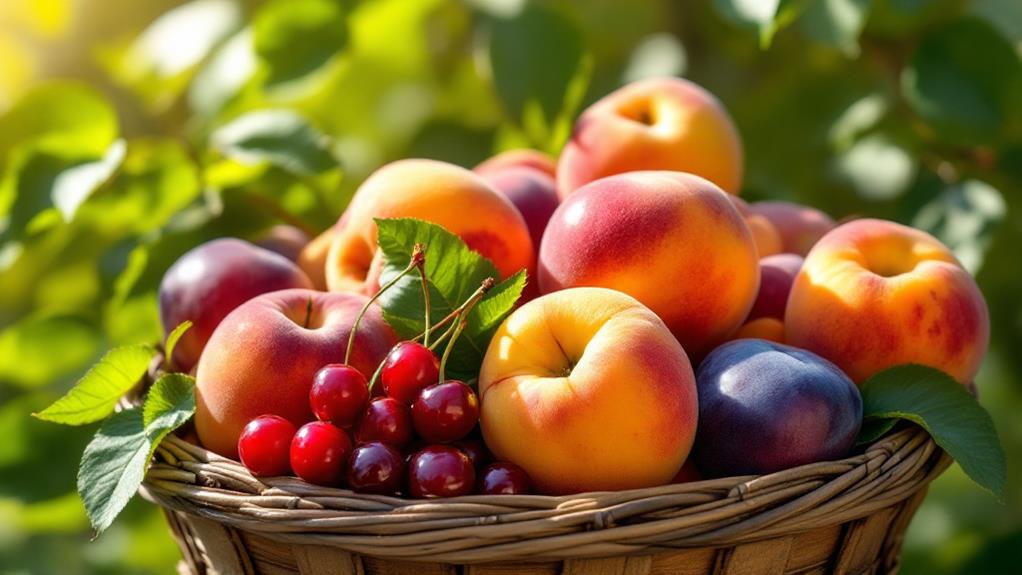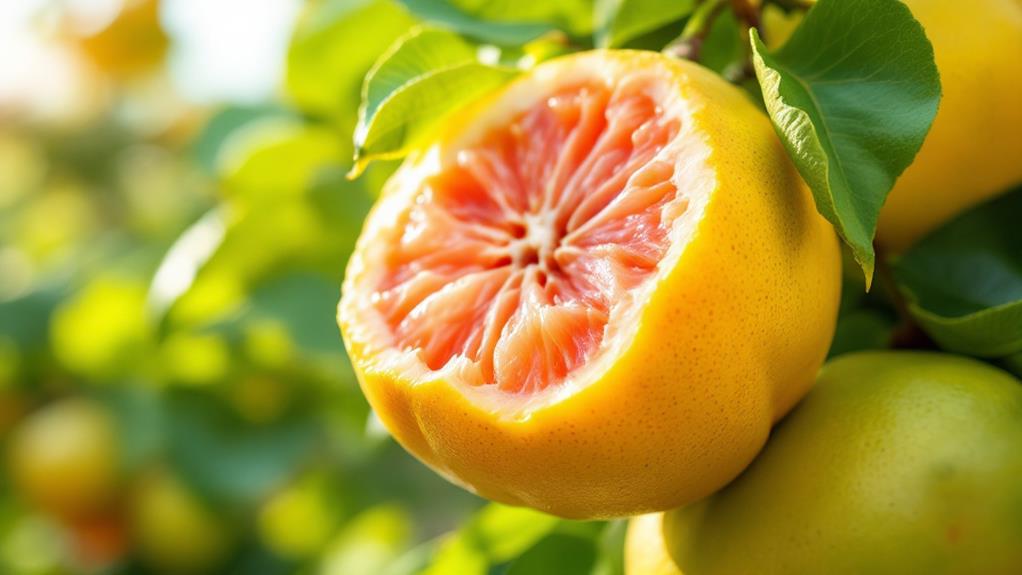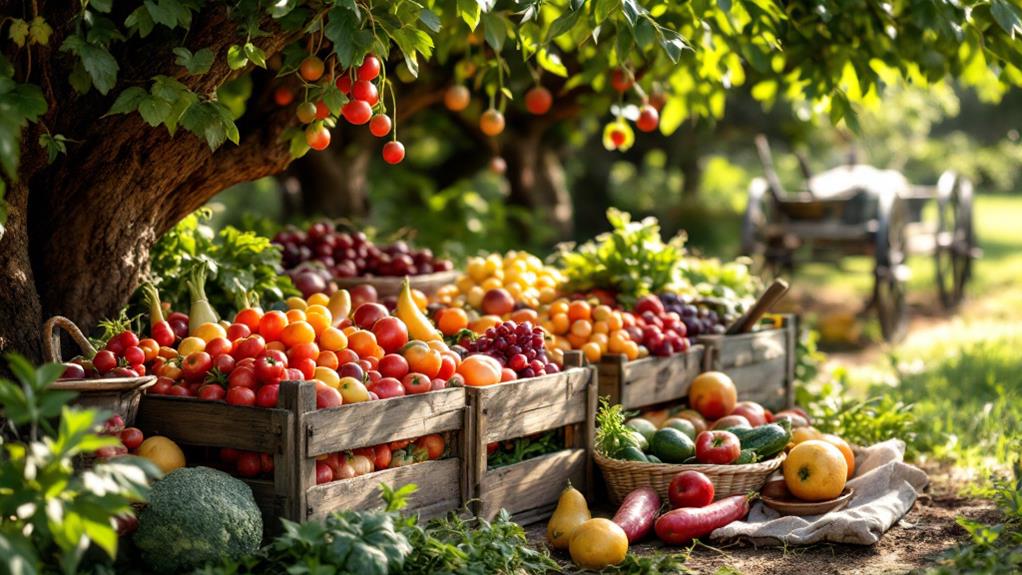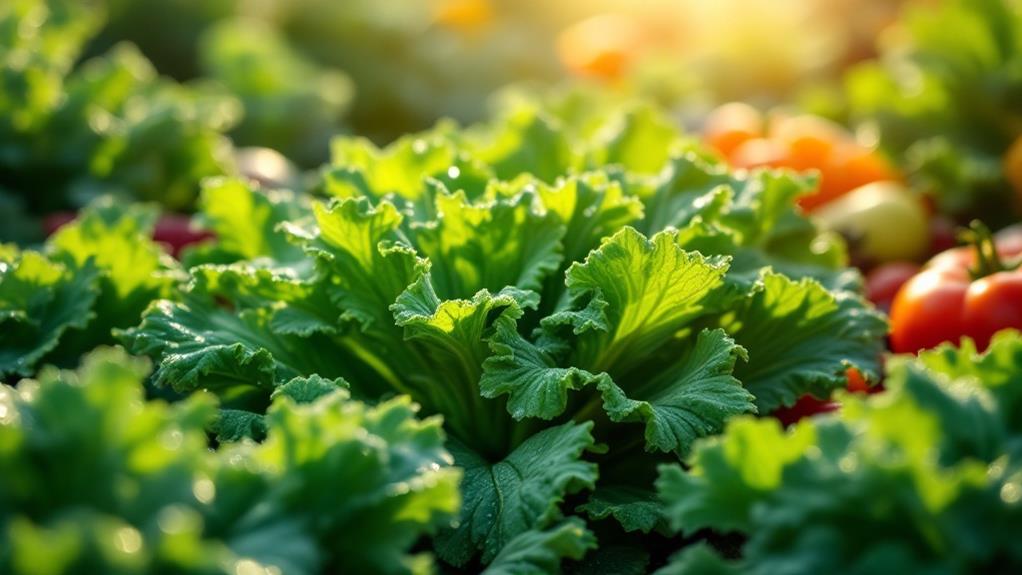Guide to Growing Longan: Tips for Growing and Enjoying This Sweet Fruit
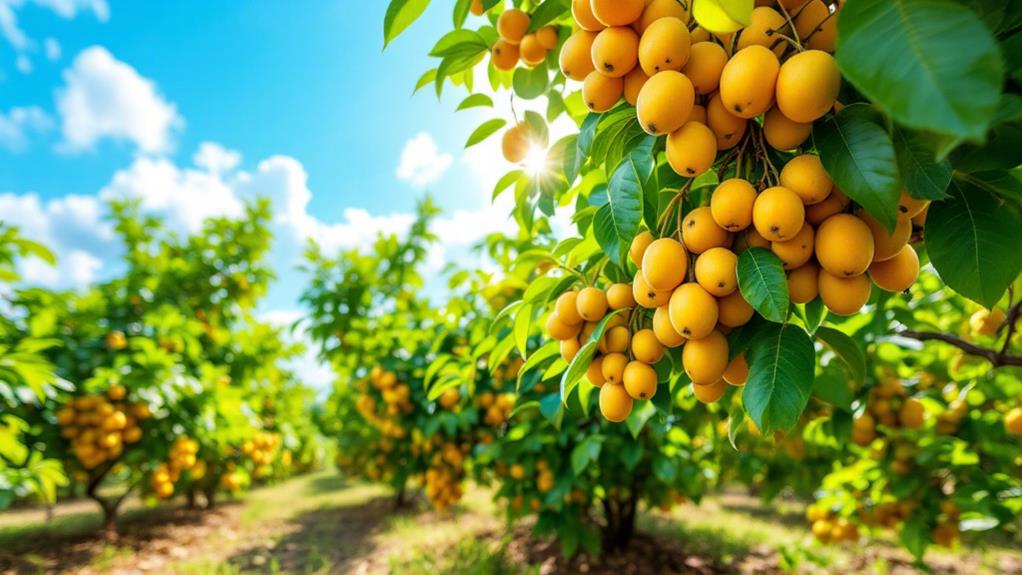
To grow longan successfully, start by selecting a spot in USDA zones 10-11 where the tree can soak up at least 8 hours of sunlight each day. Verify the soil is well-drained, preferably sandy or loamy, with a pH between 5.5 and 6.5. Plant in spring or early summer for best results, spacing trees 15-20 feet apart. Use grafted saplings for quick fruit production. Water regularly and mulch to retain moisture. Prune annually and apply a balanced fertilizer 3-4 times during the growing season. Keep an eye out for pests and challenges, and there's more to investigate.
Understanding Longan Fruit
In regards to understanding longan fruit, you'll find that it's a captivating tropical delicacy with a rich history and a unique set of characteristics. Known as "dragon eye," the longan fruit hails from southern China and stands out with its round shape, thin tan skin, and translucent sweet flesh encasing a large black seed. When you bite into this fruit, you'll immediately notice its sweet, juicy flavor, thanks to its 12-21% soluble solids and high water content of 83%.
Growing longan trees can be rewarding, especially if you're keen on harvesting this nutritious fruit, rich in antioxidants, vitamin C, and potassium. In the U.S., particularly Florida, the Kohala cultivar dominates, comprising about 99% of the acreage. These trees generally ripen from July to early September, providing a relatively heavy yield similar to that of mango trees. However, it's crucial to recognize that longan trees may experience alternate fruiting years, which can influence harvest quantities.
To guarantee successful cultivation, pay attention to the soil conditions when planting longan trees. This attention to detail in the growing process can greatly affect your eventual enjoyment of this sweet, nutritious fruit.
Optimal Growing Conditions
Cultivating longan trees successfully hinges on providing the right growing conditions. Start by confirming your environment matches USDA zones 10-11, as these trees thrive in subtropical to tropical climates for ideal growth. The key to healthy longan fruit production lies in the details of your setup.
- Sunlight: Position your longan tree where it receives full sun. At least 8 hours of direct sunlight daily is essential to support vigorous growth and enhance fruit production. Without enough light, young longan trees may struggle to develop properly.
- Soil Types: Choose well-drained sandy or loamy soil with a pH range of 5.5 to 6.5. This helps guarantee healthy root development, providing a strong foundation for your tree. While the soil should retain moisture, it must also drain well to prevent root rot, especially during heavy rainfall periods.
- Space Considerations: If space is limited, consider planting dwarf longan varieties. These compact trees allow you to enjoy the sweet longan fruit in smaller areas without compromising on growth quality or yield.
Planting Practices
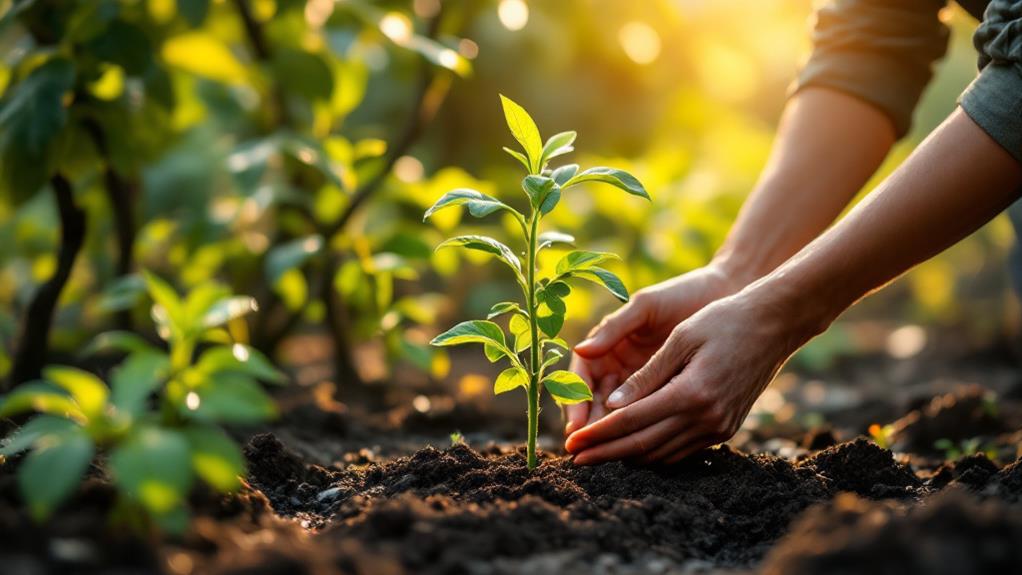
To start growing longan trees effectively, focus on proper planting practices after setting up the ideal growing environment. Begin by planting in spring to early summer, which guarantees peak establishment of your young trees in warm conditions. Space your longan fruit trees 15-20 feet apart to provide ample sunlight and room for growth, as they can reach a height of 30-40 feet.
When you're ready to plant, confirm that the nursery tree is positioned at the same soil level as it was in its pot. This prevents stress and encourages healthy root development. Backfill the hole with loose soil to avoid root compaction, allowing your young trees to establish themselves more effectively. Use well-drained soil, preferably sandy or loamy, with a pH of 5.5 to 6.5. This type of soil maintains the right balance of soil moisture, crucial for the health and growth of longan trees.
Opt for grafted saplings rather than seed-grown trees, as they mature and bear fruit more quickly. By following these planting practices, you'll set your longan trees on the path to productive growth and delicious fruit production.
Longan Tree Maintenance
Caring for your longan trees properly guarantees they thrive and produce abundant fruit. Start by focusing on their water needs. Longan trees require regular deep watering, about 2 inches weekly, especially during establishment and fruiting. This secures healthy growth and fruit production. To maintain moisture, consider adding a mulch layer of 2 to 4 inches around the tree's base, which also helps control weeds.
Key Maintenance Tips:
- Pruning: Conduct annual pruning in late winter. Remove dead or dense growth to improve air circulation and boost fruit yield. This keeps the trees healthy by allowing sunlight to penetrate and reach all parts.
- Fertilization: Apply a balanced fertilizer 3-4 times during the growing season. For young trees, use 1/4 lb of fertilizer after one month of planting to support their initial growth. Proper fertilization is vital for the longan trees' robust development.
- Pests and Diseases: Monitor regularly for common pests like leaf-footed bugs and scale insects. Use organic sprays as needed to manage infestations effectively. Keeping an eye on pests and diseases will protect your trees and guarantee they remain healthy.
Addressing Common Challenges
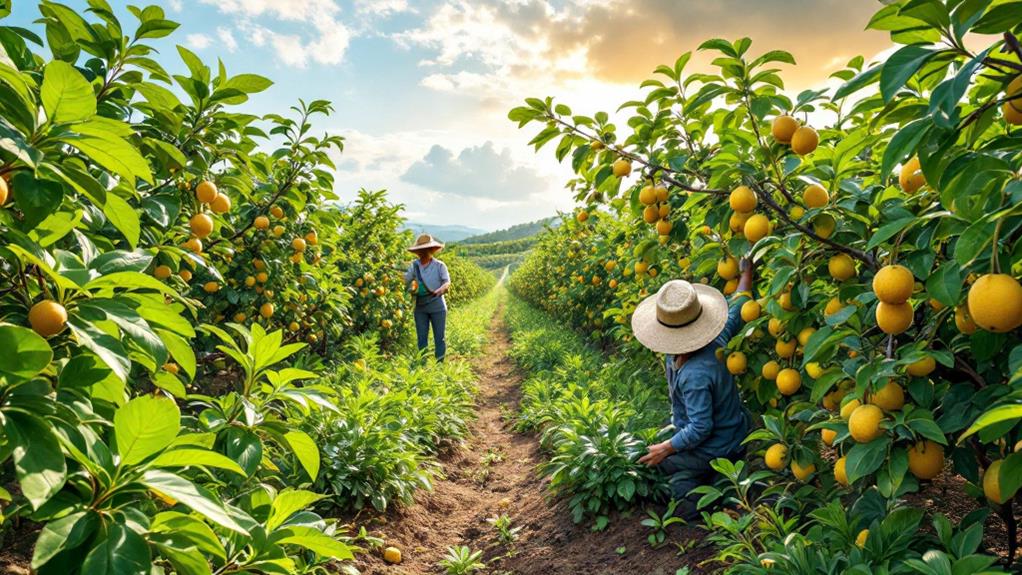
In relation to growing longan trees, you're bound to face a few challenges along the way. Initially, longan trees are sensitive to cold, especially when young. Consider planting cold-hardy varieties if your climate tends to drop below 29°F (-1°C). Drought can also be an issue, so verify your soil drains well and maintain a consistent watering schedule, especially from flowering to harvest. High humidity can lead to pest problems, so keep an eye out for pests like leaf-footed bugs and scale insects. Regular inspections and organic sprays can help control these infestations and keep your tree healthy.
Wind protection is vital in hurricane-prone areas. Mature longan trees pruned to 10-20 feet (3.1-6.1 m) can withstand strong winds, but they're not tolerant of saline conditions. To prevent excessive damage, confirm your trees are planted at the proper soil level and protected from salty environments. Excessive winter rains might interfere with flowering and fruit production, so improving drainage and choosing well-drained soil types are fundamental. By addressing these challenges, you'll increase your chances of growing a thriving, healthy tree that produces delicious longan fruit season after season.
Propagation Techniques
Release the potential of your longan garden by mastering propagation techniques that guarantee robust trees and an earlier harvest. Understanding the different propagation methods can make all the difference in your longan cultivation experience. Here are three effective techniques to evaluate:
- Air Layering (Marcottage): This method is highly favored, especially in Florida, due to its efficiency. By April to August, roots typically form within 10-12 weeks, providing you with vigorous trees that bear fruit sooner than seed-grown trees.
- Grafting: Grafting onto seedling rootstock using side veneer or cleft methods is another excellent technique. It guarantees that your trees retain the desired cultivar characteristics, leading to a more predictable harvest. Grafted trees mature faster compared to those grown from seeds.
- Cuttings: To successfully propagate longan trees from cuttings, maintain mist and bottom heat. This improves rooting success, allowing for easier propagation and the development of strong, healthy trees.
Remember to inspect any nursery trees before planting. They're usually sold in 3-gallon containers, and checking for pests and diseases guarantees their successful establishment. Familiarizing yourself with these strategies will set you up for longan growing success.
Fertilization and Irrigation
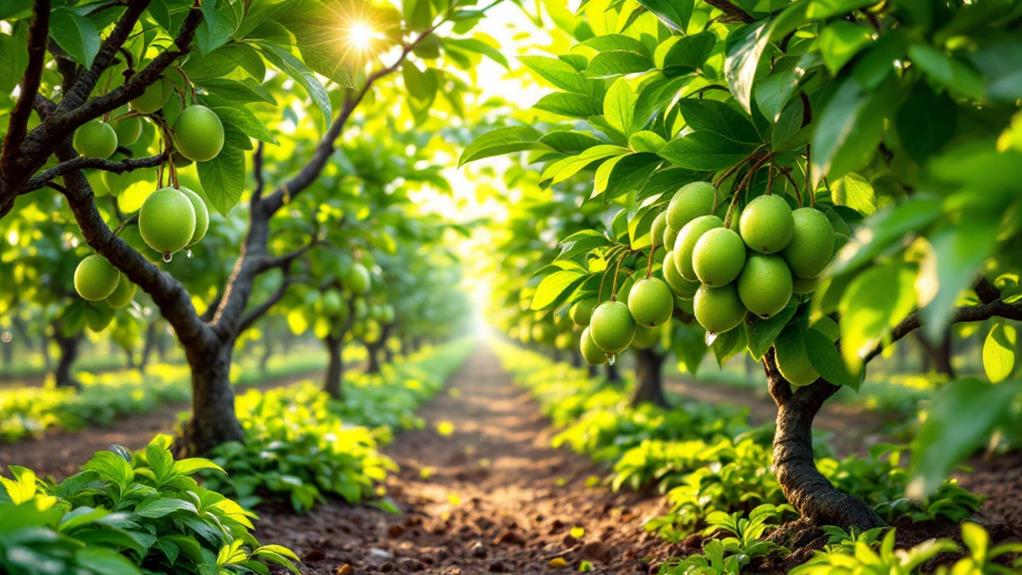
A longan tree's health and productivity hinge on proper fertilization and irrigation practices. Start with a balanced fertilizer for your young trees, using NPK ratios of 6:6:6 or 15:15:15. Begin with 1/4 lb (113 g) a month after planting, and repeat 2 to 3 times yearly for mature trees. This helps guarantee your longan's nutrient availability and supports robust fruit production. To amplify nutrient uptake further, foliar fertilizers applied 4 to 6 times a year can improve overall tree health.
Consistent irrigation is vital, especially for young trees. Newly planted longans need about 1 inch of water weekly, increasing to 2 inches during fruiting. This guarantees soil moisture is maintained, particularly during dry spells and from flowering to harvest. Young longan trees are particularly sensitive to drought, so keeping the soil consistently moist is fundamental.
Besides fertilization and irrigation, controlling weeds through manual removal or mulching is key. Weeds compete for water and nutrients, potentially hindering your trees' growth. By maintaining these practices, you'll set the stage for a thriving longan tree, rewarding you with sweet, abundant fruit.
Pest and Disease Management
While nurturing your longan tree with proper fertilization and irrigation sets the foundation for growth, keeping an eye on pest and disease management is just as crucial. Regular monitoring is key, especially for pests like the lychee webworm and scale insects. Early detection can prevent these pests from causing significant damage to your tree. Here's how you can manage pests effectively:
- Integrated Pest Management (IPM): Use organic treatments and beneficial insects to control infestations. This approach minimizes chemical use, making it safer for the environment and your tree.
- Maintain Tree Health: A healthy tree is less susceptible to pests and diseases. Guarantee proper irrigation and fertilization to strengthen your tree's natural defenses.
- Air Circulation: Improving air circulation reduces the humidity around your tree, making it less inviting for pests. Though pruning is discussed elsewhere, consider how your tree's structure affects airflow.
Diseases like red alga can be managed with prompt treatment, highlighting the importance of early detection and intervention. By staying vigilant and employing these pest management strategies, you'll help assure your longan tree remains healthy and fruitful for years to come.
Pruning and Training
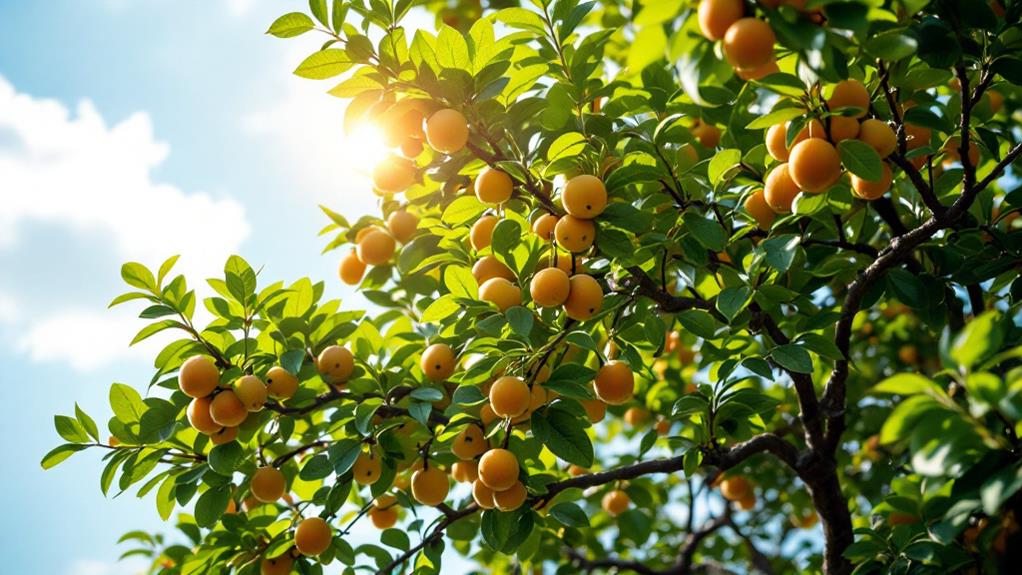
Pruning your longan tree is vital for promoting healthy growth and maximizing fruit production. Start by pruning annually in late winter. This is the perfect time to remove any dead or diseased branches, improving air circulation and sunlight penetration within the canopy. Effective pruning techniques will help guarantee your tree thrives, leading to better fruit production.
During the growing season, focus on thinning fruit clusters. By doing so, you improve the size and quality of the remaining fruits, as this allows for better resource allocation. It's significant to be selective with your pruning to manage your tree's height and spread. Mature trees should ideally be pruned to a height of 10-20 feet. This not only helps them withstand hurricane winds but also encourages healthy growth throughout the tree.
Use proper pruning techniques to avoid damage. Make clean cuts at a 45-degree angle just above a leaf node to prevent harming the tree and to promote new growth. Keep an eye on the new growth after pruning, as it can lead to improved fruiting in the following season. This attention to detail will improve your tree's overall health and productivity.
Harvesting Longans
Harvesting longans at the right time is vital to enjoy their full flavor and quality. If you're growing longans in your home landscape, you'll find the fruit typically ripens from July to early September, especially in southern U.S. climates. Look for a deeply tan color and a size comparable to a golf ball. This visual cue indicates your mature longan trees are ready for harvesting, which usually occurs a few years after planting.
To guarantee a successful harvest, follow these steps:
- Clip Carefully: Use hand clippers to gently remove clusters of fully ripe fruit. This prevents damage to the branches and guarantees the remaining fruit on the tree can continue ripening.
- Monitor Wildlife: Timely harvesting is imperative to prevent birds and other wildlife from feasting on your ripe fruits. Keeping an eye on your trees can help you collect your harvest before they do.
- Storage: After harvesting, place your longans in the refrigerator. They can stay fresh for 5-7 days, allowing you to enjoy their sweet taste at its peak.

